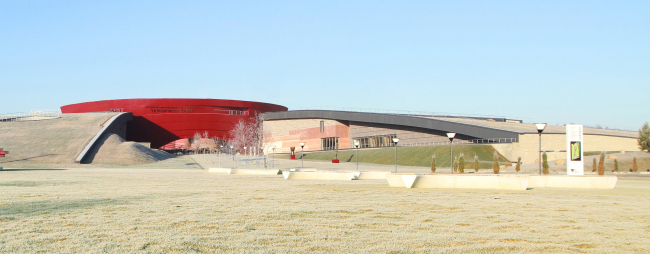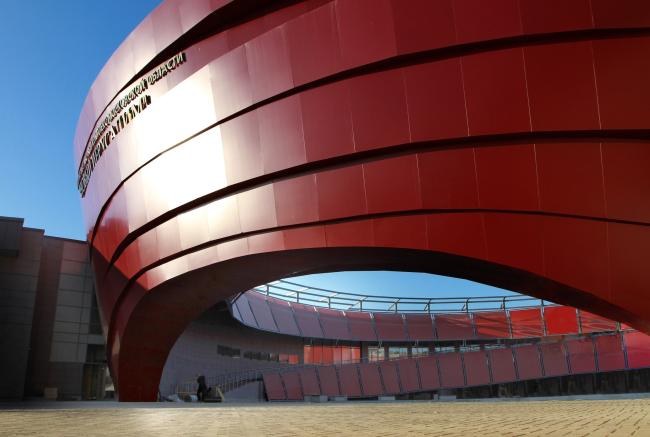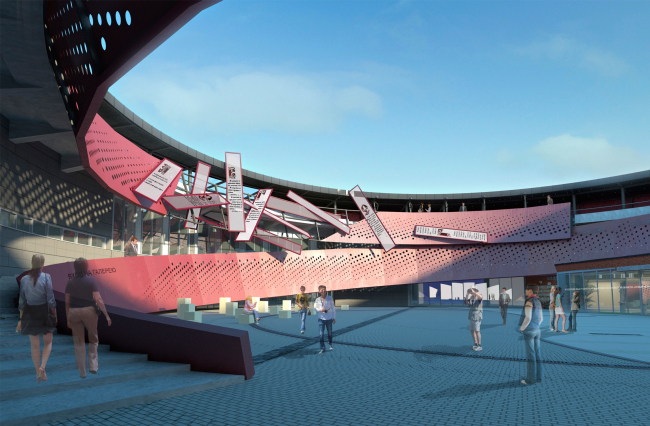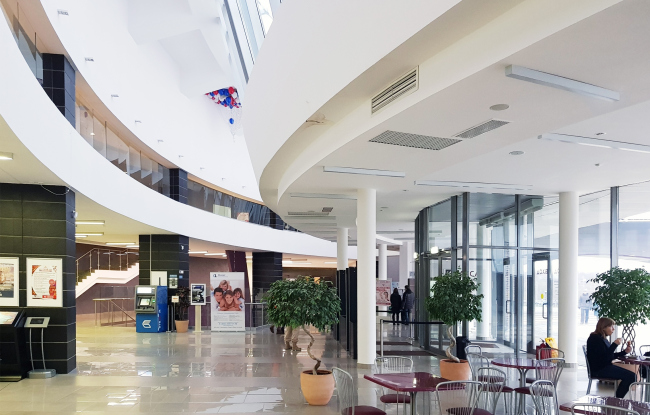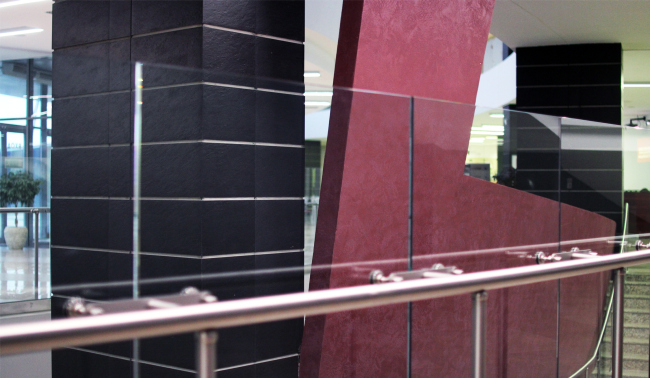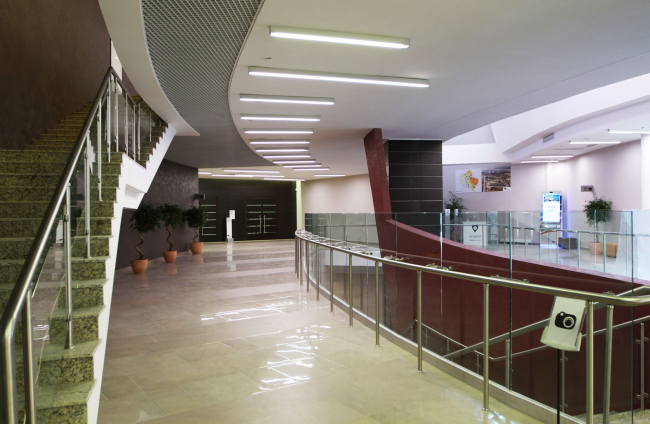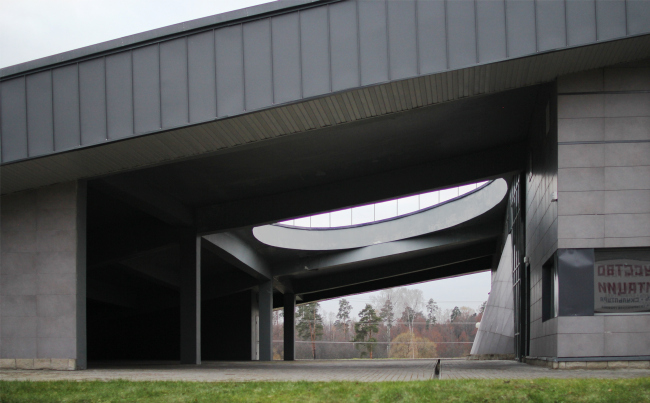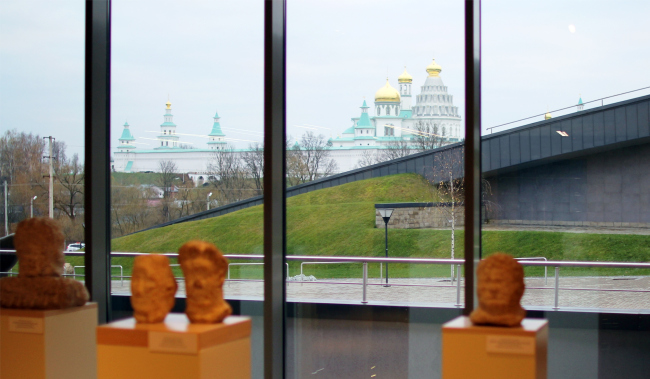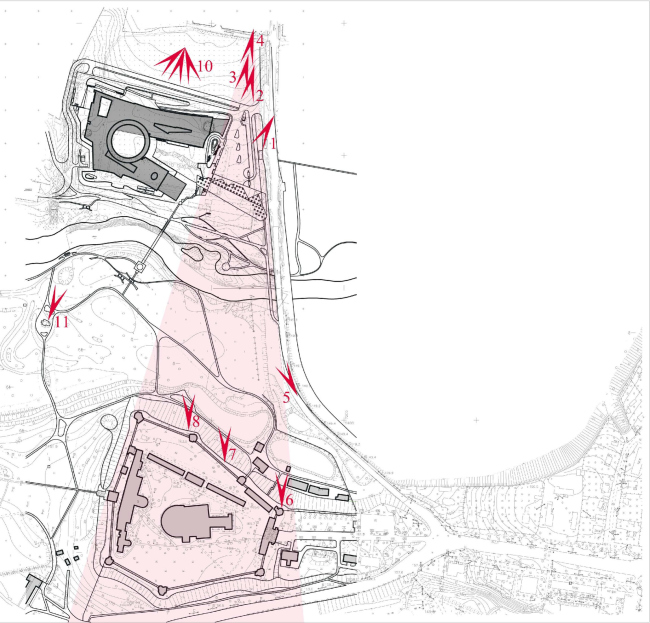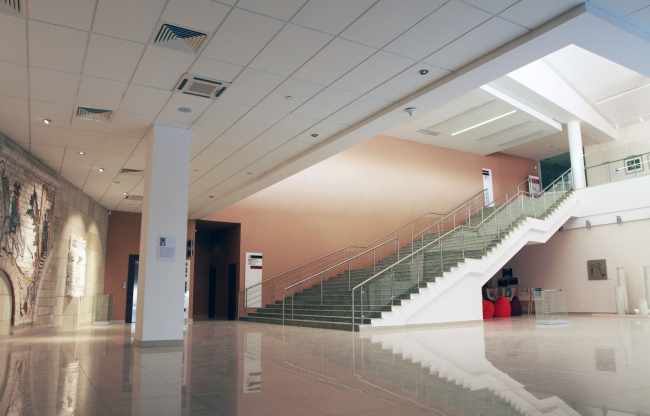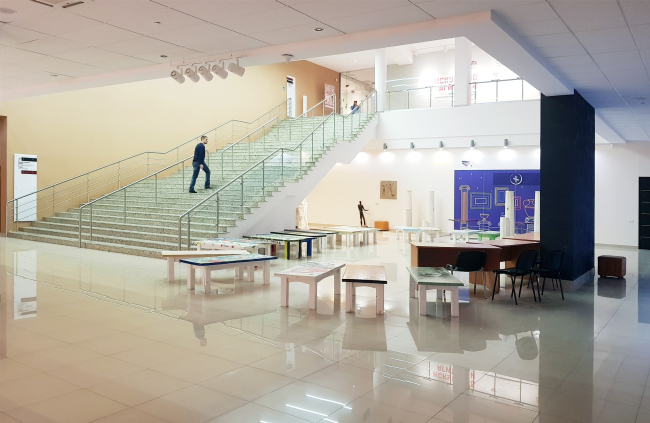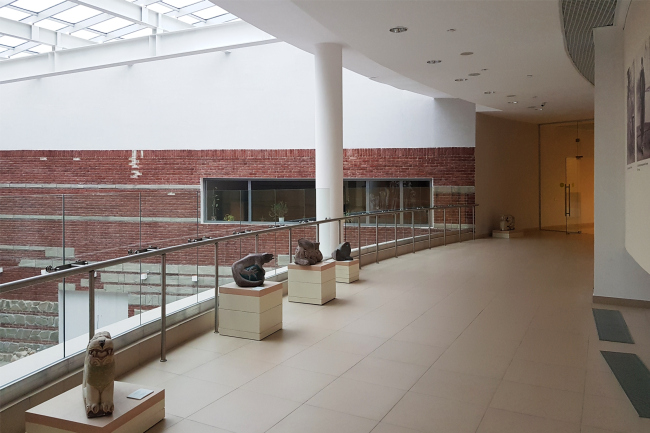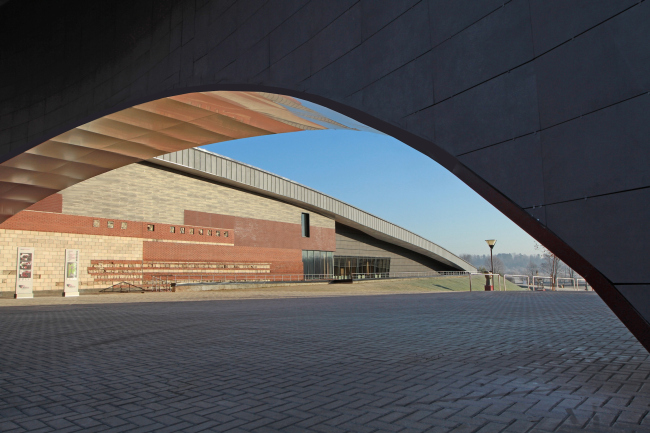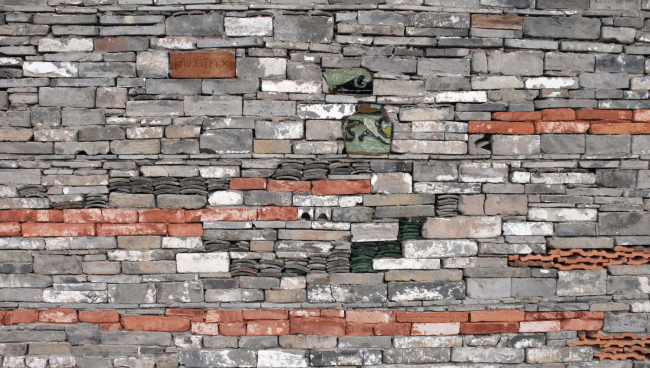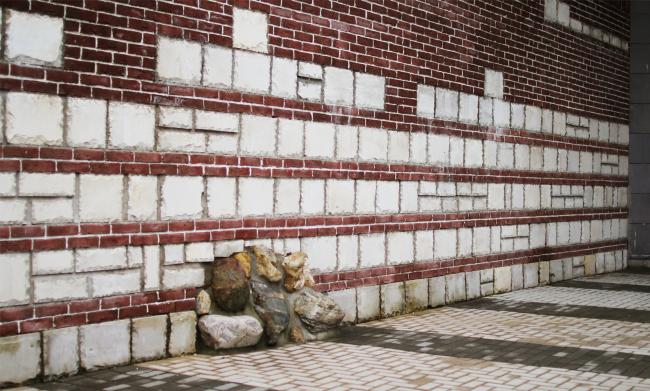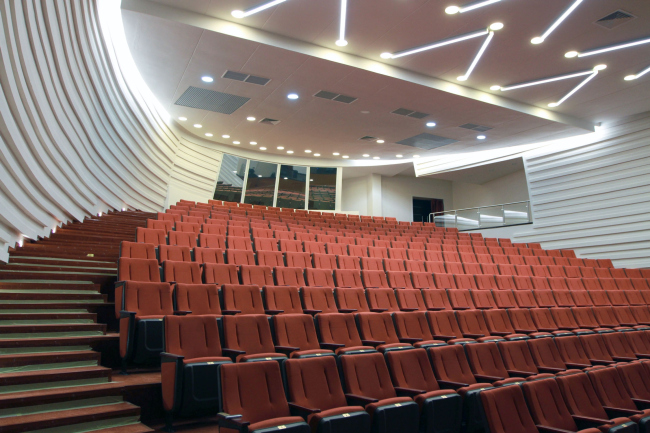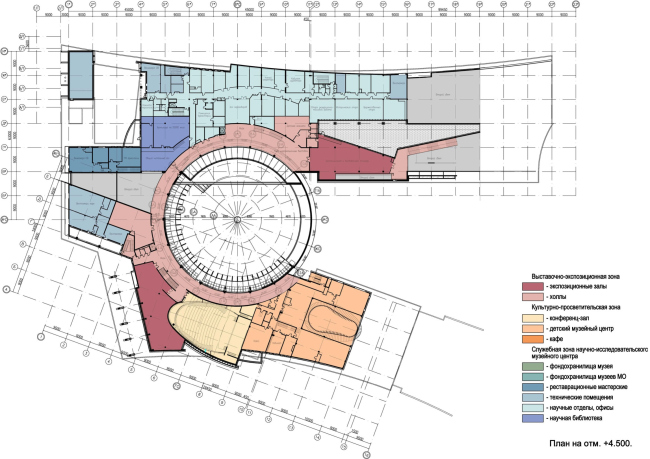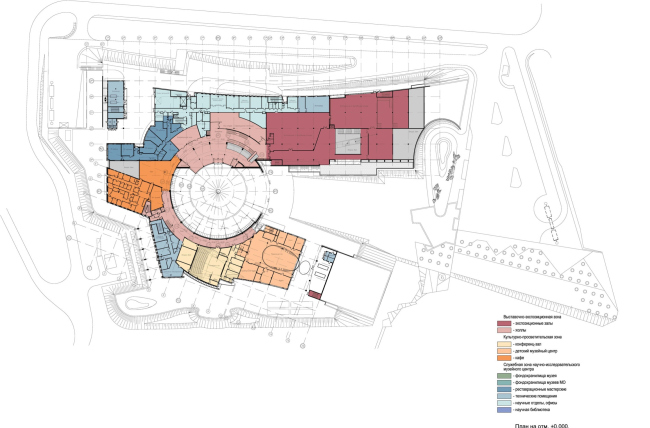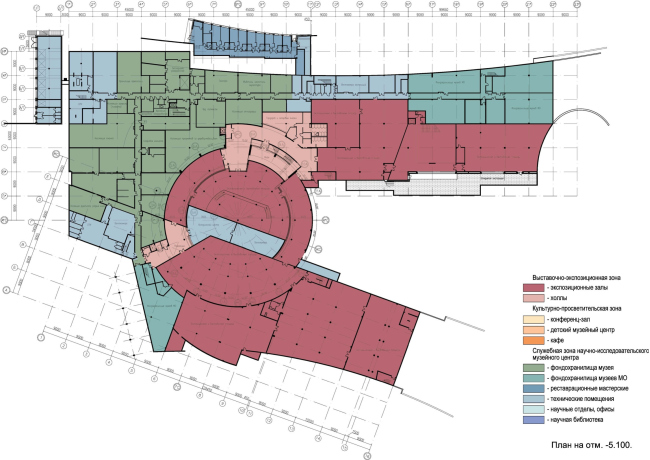|
Published on Archi.ru (https://archi.ru) |
|
| 18.01.2018 | |
|
“New Jerusalem” Hills |
|
|
|
|
| Architect: | |
| Anton Lukomsky | |
| Valery Lukomsky | |
| Studio: | |
| City-Arch | |
|
In 2013, long before Zaryadye Park was laid, City-Arch designed a museum-hill which contains the richest museum collection in the Moscow area. The museum building in "New Jerusalem". Visualization, 2013 © City-ArchActually, City-Arch was faced with a challenging task, with one boundary of the construction site being 300 meters away from the federal architectural monument, namely The New Jerusalem Monastery, and its other boundary crossing the hilly banks of the Istra River. To prevent the museum complex from being underflooded a 4-metre dam was built within the bunded area. A lot of other restrictions had to be taken into account, the chief one of them being height restriction which was based on the results of the visual landscape analysis. A four-hectare site was to accommodate 28 000 square meters of the museum space so some exhibitions were placed below the ground level.  The museum building in "New Jerusalem" © City-ArchThus, on the one hand, the building stands above the ground waters and the probable river wave level, and on the other hand, it is a part of the landscape, having been turned into an artificial 12-metre hill. The museum buildings which constitute most of the hill are literally spread along its perimeter. And in the center of an open trapezoid you can see the centerpiece of the complex, a round structure with galleries along the walls and a large round square in the middle. The round square seems to couple with a giant hipped roof above the Edicule, which is the main symbol of Patriarch Nikon’s New Jerusalem Monastery, and the museum square repeats it the other way round: emptiness versus completeness, ledges versus offsets, accompanied with a similar roundabout way and the same design stretching from the east to the west. When seen from Buzharovskoye Highway, the round structure resembles The Holy Grail because of its deep colour of aged red wine and its contrast with the prevailing grey and green colour scheme of the adjacent buildings. The museum building in "New Jerusalem". Realization, 2013 © City-ArchThe museum building in "New Jerusalem". Realization, 2013 © City-ArchThe museum building in "New Jerusalem". Realization, 2013 © City-ArchThe museum building in "New Jerusalem". Realization, 2013 © City-ArchThe museum building in "New Jerusalem". Realization, 2013 © City-ArchThe museum is quite rich in unique treasures. The collection of the New Jerusalem Art and History Museum which was started almost a hundred years ago, in 1920, now contains approximately 180 thousand objects and is considered the biggest one in the Moscow Oblast. In the New Jerusalem Monastery of Resurrection, not more than 9 000 square meters of exhibition space were available for the collection. Besides, massive construction to restore the monastery buildings was underway, which also affected the collection. In 2008, the Russian authorities separated the monastery and the museum, initiating both the monastery restoration and the construction of a new museum complex on the territory of 28 000 square meters. Architecturally, the museum is a part of the monastery ensemble: the southern wing of the museum inside the hill runs parallel to the monastery wall. In fact, the territories of the complexes are connected with a footbridge, and you can see a lot of trees while you walk from the monastery to the museum along this footbridge so the museum sinks out sight and reappears again. Another route to the museum runs from the parking lot near the highway where tourist buses arrive and from where you can see the main entrance with a wide arch cut in the dark-red wall of the round structure which leads to the inner square where various events, concerts and exhibitions of art objects are held and which hosts a café in the summertime. You can also climb the spiral galleries that bring to mind Wright’s Guggenheim Museum in New York City, the prototype of many XX-century museums, and listen to a concert from an unusual “elevated” point. The museum building in "New Jerusalem". Visualization, 2013 © City-ArchCafe in the museum lobby. The widening spiral vortex of the yard yields a very attractive band of secondary light - there is plenty of light inside even on a cloudy day. The museum building in "New Jerusalem". Realization, 2013 © City-Arch. Photograph © JThe red wall of the round complex echoes in the halls of the museum as well, manifesting the connection between the interior and the exterior of the building and giving the impression of a gigantic puzzle which consists of a variety of different elements joined together. So it is quite fascinating to spot something seen outside on the inside. But then again, inside, the red color is given not by panels but by painted stucco. But the color is the same, it is quite recognizable. The museum building in "New Jerusalem". Realization, 2013 © City-Arch. Photograph © Julia Tarabarina, Archi.ruThe museum building in "New Jerusalem". Realization, 2013 © City-ArchThe lobby with a fragment of the red wall. The museum building in "New Jerusalem". Project, 2013 © City-ArchBesides, some exhibition halls have huge panoramic windows overlooking the monastery complex. A magnificent view opens from the eastern atrium in the northern exhibition wing of the building: looking through a glass wall you can see Patriarch Nikon’s hermitage framed by a small yard, obviously cut in the southern storage wing of the museum for this very purpose. This small yard was not a part of the original project but was added later once the architects noticed the beauty of the view: the hermitage illuminated from above appears glowing, almost like round churches in the vedute painted by the Masters of the Renaissance. View of Patriarch Nikon’s cell in the opening of the museum's south wing. The museum building in "New Jerusalem". Realization, 2013 © City-Arch. Photograph © Julia Tarabarina, Archi.ruThe little yard, cut as the "range finder" in the sounth wing of the museum. The museum building in "New Jerusalem". Realization, 2013 © City-Arch. Photograph © Julia Tarabarina, Archi.ruThus, this magnificent view is an integral part of the museum exhibition, something from the outside entering the museum. And it is obviously a creative architectural idea to highlight the vicinity of the monastery. Vew of the monastery from the north wing of the museum. The museum building in "New Jerusalem". Realization, 2013 © City-Arch. Photograph © Julia Tarabarina, Archi.ruCalculation of the lines of vision and viewing perspectives from the museum to the monastery and backwards. The museum building in "New Jerusalem" © City-ArchOnce inside the museum, you can enjoy walking about it even without visiting the exhibition area. Apart from an entrance hall and galleries illuminated by the natural light coming from the panoramic windows along the yard’s perimeter, the exhibition wing also has two atriums, the western one with a café and the eastern one with a wide three-flight staircase and a big multifunctional hall. All those spaces contain exhibits as well as the exhibitions halls, only fewer, and create an atmosphere of an actual museum like, for instance, in the Baths of Diocletian in Rome you can find something interesting in every corner. The east atrium of the north wing. The museum building in "New Jerusalem". Project, 2013 © City-ArchThe east atrium of the north wing. The museum building in "New Jerusalem". Realization, 2013 © City-Arch. Photograph © Julia Tarabarina, Archi.ruThe east atrium of the north wing. The museum building in "New Jerusalem". Realization, 2013 © City-Arch. Photograph © Julia Tarabarina, Archi.ruThe west atrium of the north wing - the space of the museum cafe, view from the balcony. The museum building in "New Jerusalem". Realization, 2013 © City-Arch. Photograph © Julia Tarabarina, Archi.ruThe archaeological dimension is also created by a wall at the excavation site where you can see materials and artefacts connected with the monastery, including chalkstone taken from the restoration sites on the territory of the monastery and five-colour tiles specially designed by the architects but not borrowed from the museum collection as one might think. This ornamental and architectural setting is present both in the exterior and the interior, thus producing an impression of an excavation hill, a museum in the archeological space. To tell the truth, it is not a real excavation site but a skillful imitation though together with a panoramic view of the monastery it does give an impression of authenticity. The museum building in "New Jerusalem". Realization, 2013 © City-ArchThe museum building in "New Jerusalem". Realization, 2013 © City-ArchThe museum building in "New Jerusalem". Realization, 2013 © City-ArchFragment of the "archaeological wall" in the main building of the museum. The museum building in "New Jerusalem". Realization, 2013 © City-Arch. Photograph © Julia Tarabarina, Archi.ruThe architects of the project made special efforts to design the functional programme of the museum: the original technical design specified only the total floor area, and 20 000 square meters out of 28 000 were allocated to the exposition, so now the museum occupies the area twice as large as it used to. Thus, the new building has not only the exhibition zone, which was mostly created by the Saint-Petersburg center “Raritet”, but also a cultural and educational zone, which includes a double-height café and two levels with a children’s club, a state-of-the-art conference hall (both equipped with big skylights), and a research library. The café is adjacent to the restoration workshops that also function as a hotel for artists who come to work here. Conference hall. The museum building in "New Jerusalem". Project, 2013 © City-ArchThe museum building in "New Jerusalem". Plan at the +4.500 notch © City-ArchThe museum building in "New Jerusalem". Plan at the zero notch © City-ArchThe museum building in "New Jerusalem". Plan at the -5.100 notch © City-ArchThe original project included windows in the workshops which would allow the visitors to have a look at the restoration artists working. However, later the idea had to be abandoned. Unfortunately, some other parts of the original project were not realized either. Instead of dark-red composite panels, the round structure of the museum was covered with red vinyl fabric. Neither an observation deck overlooking the monastery that was supposed to be located on the spiral gallery running within the round structure nor the accessible roof area of the hill where you could walk enjoying the view were actually built. The proposed idea of the way connecting the monastery with the museum hill and then running up and down along the spiral ramps had been meant to be a spatial leitmotif, a unifying theme with its upturns and downturns, and having lost this expressive means the museum now lacks many things. The engineering systems and technological solutions, which were designed and proposed by City-Arch and received a lot of awards, have not been implemented. However, the original project seriously focused on energy conservation and Passive House technology (if the warmth-keeping system had been installed according to the original design, the museum would not need a heating system, which is crucially important for a building located far from the central heating lines). Through the contractor’s negligence the dam and the hydrofuge insulation were built with numerous defects, which now results in regular flooding of the museum depositories. This complex and interesting project, which could be perfect in so many ways, is still incomplete. It is not a secret that low construction quality is a curse of Russian architecture on a wide scale. However, the building is being actively used and developed, and maybe one day some construction defects can be repaired. Anyway, the museum is a part of the modern trend in Russian architecture, a fine example of a museum-hill, the idea of which was probably presented for the first time in the project of Strelna Museum, the winner of the 2007 competition. The same idea was realized in the Kulikovo Polye Museum, around the same time as the New Jerusalem project was launched, and in the recently opened Zaryadye pavilions as well. The essence of the projects is the same: a museum gets down into the ground turning into an artificial hill and an observation deck at the same time so the viewers perceive space in its many aspects while looking around or finding themselves deep underground, in a “cave”. You can enjoy a wide range of experiences, as the museum exists on the border between present-day reality of views, space and light, and the historical reality of preserved and exhibited monuments. And this is exactly where a museum is supposed to be located. |
|

